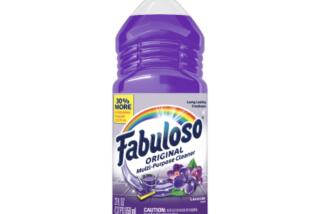Bausch Delayed Case Reports, FDA Says
- Share via
Bausch & Lomb Inc. delayed telling U.S. regulators about 35 cases of a blinding eye infection in Singapore linked to its recalled ReNu with MoistureLoc contact lens cleaner, the Food and Drug Administration said Tuesday.
The eye-care company waited more than a month before reporting the cases and failed to notify the agency in writing that the product had been withdrawn in February from the Singapore and Hong Kong markets, the FDA said Tuesday in a report.
Bausch & Lomb also failed to follow procedures to prevent contamination at the Greenville, S.C., factory that made the cleaner, the FDA said. The company Monday said it would stop making ReNu with MoistureLoc worldwide. The plant’s deficiencies weren’t the cause of any of the 122 U.S. cases of the Fusarium keratitis eye infection, according to the FDA.
“The company was asleep at the switch with this one,” said Ira Loss, who has been monitoring the FDA for more than two decades at Washington Analysis, a research firm that advises institutional investors. “It’s mostly what they didn’t do -- easy stuff, like reporting side effects to the agency within 30 days.”
The agency’s findings were among 20 “observations” resulting from almost two months of inspections by the FDA after a jump in reports of the rare, blinding eye fungus linked to MoistureLoc. The FDA posted the report on its website Tuesday.
Shares of the Rochester, N.Y.-based company fell $1.37, or 2.7%, to $48.71. The stock had gained 13% on Monday after losing 35% of its value this year through Friday.
The company is working with the FDA “to address the agency’s observations and take immediate, appropriate corrective actions,” Bausch & Lomb spokeswoman Meg Graham said.
Bausch & Lomb’s lens cleaners are used by a quarter of the 30 million Americans who wear contact lenses.
A report of the Fusarium cases in Singapore “was not submitted within 30 days of receiving or otherwise becoming aware of information that reasonably suggests that a marketed device may have caused or contributed to a death or serious injury,” the FDA said in its report. “None of the complaints were reported to the agency as of April 7, 2006.”
Some complaints were reported to Bausch & Lomb as early as July 2005, the FDA said. Details of those patients still hadn’t been conveyed to the agency as of May 9, the FDA said.
The eye infections may be related to the product’s design and how consumers use it rather than any plant contamination, the FDA said. Agency inspectors cited Bausch & Lomb for failing to perform product design reviews, validate process changes, document procedures for controlling environmental conditions, implement procedures to prevent mix-ups in storage and conduct quality audits.
“This is classic poor management in the oversight of manufacturing,” said Loss at Washington Analysis. “There have been warning signals out there about these problems for a while.”
The next step will be for the three FDA inspectors who led the inspection to submit a detailed report for review by agency officials. The FDA’s options include meeting with Bausch & Lomb management, issuing a warning letter and seizing products.
In most cases, companies voluntarily correct manufacturing problems after receiving a warning letter, said Tim Ulatowski, director of the FDA office of compliance in the center for devices and radiological health. He said the FDA might not take any further action.
More to Read
Inside the business of entertainment
The Wide Shot brings you news, analysis and insights on everything from streaming wars to production — and what it all means for the future.
You may occasionally receive promotional content from the Los Angeles Times.










